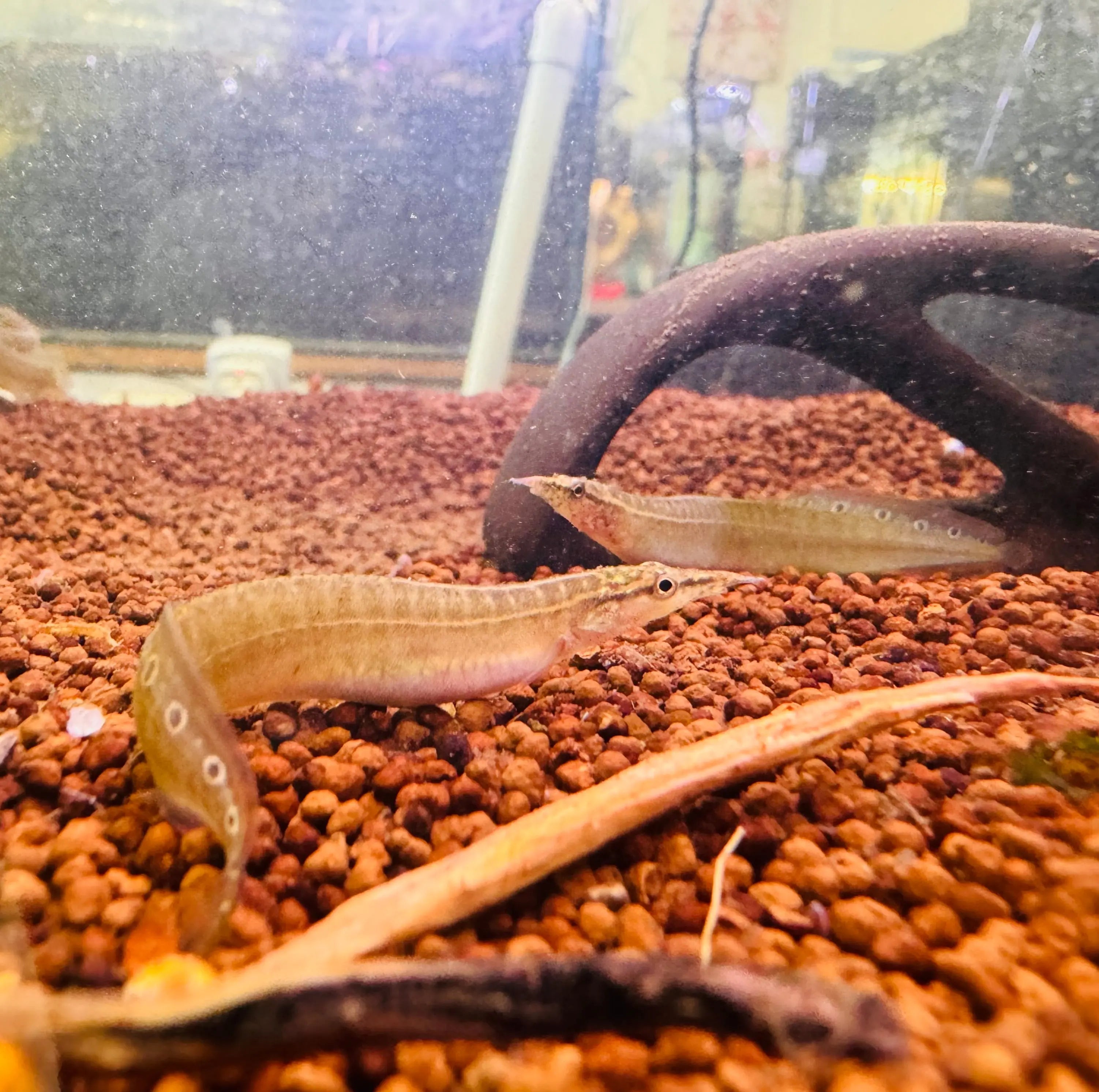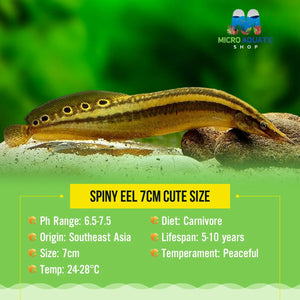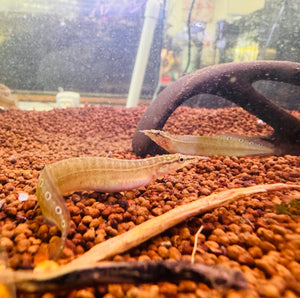Spiny Eel 8cm Show
Order today - receive it in as little as 3-5 days.
Return within 30 days of purchase. Duties & taxes are non-refundable.
Guarantee Safe Checkout

Spiny Eel 8cm Show
Spiny Eel - Unique Freshwater Fish for Aquariums
The Spiny Eel is a standout in the world of aquarium keeping, especially for Australians. Known as the Australian eel or striped eel, it brings a unique and stunning look to any tank. At Micro Aquatic Shop, we're excited to share this amazing fish with our customers, opening doors to exotic aquatic life.  Spiny eels grab your eye with their long, snake-like bodies and spines. They're not just any fish; they have a special charm that makes them stand out. This makes them a top choice for those wanting to add something unique and eye-catching to their aquarium.
Spiny eels grab your eye with their long, snake-like bodies and spines. They're not just any fish; they have a special charm that makes them stand out. This makes them a top choice for those wanting to add something unique and eye-catching to their aquarium.
Key Takeaways
- Spiny eels are a unique and captivating freshwater fish species for aquariums
- Highly sought-after by Australian hobbyists for their distinctive appearance and exotic appeal
- Available at Micro Aquatic Shop, a leading provider of rare and unique aquatic life
- Offer a visually stunning addition to any aquarium setup with their elongated, serpentine bodies and spines
- Provide a gateway for aquarium enthusiasts to explore the fascinating world of exotic aquatic creatures
Introduction to Spiny Eel Species
Spiny eels are fascinating freshwater fish that aquarium lovers all over the world find intriguing. They belong to the Mastacembelidae family. These fish have eel-like bodies, long fins, and spines along their backs. Let's dive into their world and learn about their origins, physical traits, and the different species found in aquariums.
Origins and Natural Habitat
Spiny eels come from tropical and subtropical Asia. Their homes include slow rivers, streams, and ponds. They can live in many places, showing how adaptable and strong they are.
Physical Characteristics
Spiny eels have long, snake-like bodies. They vary in size, from the small slender sea eel to the big snake eel. Their bodies have small scales and spines along their backs. These spines help protect them from predators.
Common Species Varieties
In aquariums, you can find many Spiny Eel species. Popular ones are the slender sea eel, snake eel, and venomous eel. They come in bright colors like reds and yellows, or more calm browns and greens. They add beauty to any aquarium. Exploring Spiny Eels, remember they need special care to do well in aquariums. With the right setup and care, they can be the highlight of a stunning freshwater display.
Setting Up the Perfect Tank Environment
We know how important it is to create a great home for our indo-pacific eels and reef-dwelling eels. A perfect tank environment is essential for their well-being. It lets them thrive in our care. The right substrate is key. Choose a fine, soft sand or gravel for burrowing and hiding. Adding aquatic plants can make the tank feel more natural.
- Make sure the substrate is at least 4-6 inches deep for burrowing.
- Provide hiding spots like driftwood, rocks, and artificial caves to meet their instincts.
Eels prefer well-oxygenated, slightly acidic water. Keep the pH between 6.5 and 7.5 and the temperature between 22-26°C. Regular water changes and good filtration are vital for clean water.
| Parameter | Ideal Range |
| pH | 6.5 - 7.5 |
| Temperature | 22 - 26°C |
| Ammonia | 0 ppm |
| Nitrite | 0 ppm |
| Nitrate |
The tank size is also important. Aim for a minimum of 100 litres for one eel. Add 50 litres for each extra eel. This ensures they have enough space to be themselves. By following these tips, you can make a great home for your indo-pacific eels and reef-dwelling eels. Check out Micro Aquatic Shop for the right products. Let's start this exciting journey of eel-keeping together!
Feeding and Nutrition Requirements
Keeping your spiny-tailed eel or australian eel healthy means giving them the right food. These interesting fish need specific foods to stay well in their tank. We'll look at what they like to eat, the best foods, and how often to feed them.
Natural Diet Preferences
In the wild, these eels mainly eat small fish, crustaceans, and insects. They use their sharp teeth to catch and eat their food.
Recommended Food Types
For your eel's tank, try to feed them like they do in the wild. Good foods include:
- Live or frozen brine shrimp
- Bloodworms
- Small feeder fish, such as guppies or minnows
- High-quality, sinking pellets or flakes for carnivorous fish
Feeding Schedule Tips
Feed your eel a mix of foods, but not too much. Aim for meals that last 2-3 minutes, 2-3 times a week. Don't overfeed, as it can harm their health. A regular feeding schedule helps keep them healthy. Knowing what your spiny-tailed eel or australian eel needs to eat is key. This way, you can give them a happy and healthy home. Always check reliable sources to make sure you're feeding them right.
Tank Mates and Compatibility Guide
Setting up a harmonious aquarium for Spiny Eels requires careful tank mate selection. These freshwater fish have specific needs that are crucial for a community tank's success.  Striped eels and snake eels are generally peaceful. But, they can be shy and timid, especially in new environments. To ensure peace, choose tank mates that match their size, temperament, and water needs.
Striped eels and snake eels are generally peaceful. But, they can be shy and timid, especially in new environments. To ensure peace, choose tank mates that match their size, temperament, and water needs.
- Ideal tank mates for Spiny Eels include peaceful, bottom-dwelling species like corydoras catfish, loaches, and certain tetras or barbs.
- Avoid aggressive, territorial, or fast-moving fish that may intimidate or outcompete the eels for food and hiding spots.
- Similarly, large, predatory fish should be off the table, as they may view the eels as a potential meal.
| Recommended Tank Mates | Unsuitable Tank Mates |
| Corydoras Catfish | Cichlids |
| Loaches | Angelfish |
| Tetras | Larger Predatory Fish |
| Barbs | Aggressive Dwarf Cichlids |
By choosing the right tank mates and providing hiding spots, we can create a thriving community for our Spiny Eel friends.
Health and Maintenance Tips
Keeping your slender sea eel or venomous eel healthy is important. It requires some effort, but it's worth it. We'll cover common health issues, how to manage water, and a regular care routine. This will help keep your eel happy and healthy for a long time.
Common Health Issues
Eels are generally tough, but they can get sick. Some common problems include:
- Skin infections, often caused by poor water quality or injury
- Parasitic infestations, such as flukes or ich
- Digestive disorders, often related to improper feeding or stress
Watching your eel closely can help you spot problems early. Then, you can fix them quickly with help from an expert or vet.
Water Parameter Management
Keeping the water right is key for your eel's health. They like slightly acidic, warm water. Make sure it's well-filtered and has plenty of oxygen. Regular checks and tweaks to pH, temperature, and other factors will keep your eel happy.
Regular Care Routine
Having a regular care routine is essential for a happy eel. This includes:
- Doing partial water changes of 10-20% weekly to keep the water clean and fresh
- Cleaning the substrate and decorations well to remove waste and uneaten food
- Watching your eel's appetite and adjusting food as needed to keep them in good shape
- Keeping an eye on your eel's behaviour and looks for any signs of illness or stress
By following these care steps, you can enjoy your eel's beauty for many years.
Breeding and Reproduction Insights
Captive breeding of the indo-pacific eel and reef-dwelling eel is a challenge. But with the right steps, we can unlock their secrets. These fish have won the hearts of many aquarium lovers. Knowing how to breed them is key to their survival and for future hobbyists. One big challenge is mimicking their natural spawning cues. These fish need specific water changes and pH levels to start breeding. By carefully adjusting the tank, we can help them spawn successfully. It's also important to feed them the right food. Indo-pacific eels and reef-dwelling eels have special diets. A balanced diet with live foods like small fish and shrimp can help them breed. When it comes to caring for eggs and fry, patience is key. We need to manage water quality, feed them, and protect them from predators. Watching over the young indo-pacific eels and reef-dwelling eels closely can help them thrive.
| Breeding Factors | Optimal Conditions |
| Water Temperature | 24-28°C |
| pH | 6.8-7.6 |
| Lighting | Moderate, with hiding spots |
| Diet | Live foods, such as small fish, shrimp, and worms |
By following these insights, we can help conserve and breed these amazing indo-pacific eels and reef-dwelling eels. This way, they can stay in our aquariums for many years.
Conclusion
The spiny-tailed eel, or Australian eel, is a captivating freshwater fish. It can be a great addition to any aquarium. They have a unique look, interesting behaviors, and specific care needs.
 We've looked at the different species, how to set up the perfect tank, and how to feed and keep them healthy. Knowing their origins, looks, and how they get along with others helps you care for them well. If you're interested in spiny-tailed eels, check out Micro Aquatic Shop. They offer exotic aquatic species and expert advice. Their team can help you choose the right eel, set up the best tank, and care for your new pet. Start an exciting journey with these unique freshwater fish in your aquarium.
We've looked at the different species, how to set up the perfect tank, and how to feed and keep them healthy. Knowing their origins, looks, and how they get along with others helps you care for them well. If you're interested in spiny-tailed eels, check out Micro Aquatic Shop. They offer exotic aquatic species and expert advice. Their team can help you choose the right eel, set up the best tank, and care for your new pet. Start an exciting journey with these unique freshwater fish in your aquarium.FAQ
What are the key characteristics of the Spiny Eel?
The Spiny Eel is a unique freshwater fish. It has a long, slender body and a rounded snout. It also has rows of small spines along its back. These eels are found in Australia and the Indo-Pacific region, living in various water habitats.
What are the most common Spiny Eel species found in the aquarium trade?
Popular Spiny Eel species for home aquariums include the Australian Spiny Eel and the Striped Eel. Other species are the Snake Eel, the Slender Sea Eel, and the Spiny-tailed Eel. Each has its own look and care needs.
What are the essential elements for setting up a Spiny Eel's ideal tank environment?
For a great Spiny Eel tank, use sand or fine gravel for burrowing. Add lots of hiding spots and live plants for security. Keeping the water stable, with a slightly acidic pH, is key for their health.
What should we feed Spiny Eels, and how often should we feed them?
Spiny Eels eat small prey like crustaceans and mollusks in the wild. In tanks, feed them live, frozen, or freeze-dried foods like brine shrimp and bloodworms. Feed them a few times a week, adjusting the amount based on their appetite.
Which tankmates are the most compatible with Spiny Eels?
Choose tankmates that are peaceful and not too big. Good choices include some tetras, rasboras, and small catfish. Avoid larger, boisterous fish that might stress or prey on them.
What are some common health concerns for Spiny Eels, and how can we prevent them?
Spiny Eels can get skin infections, parasites, and suffer from poor water quality. Keep the water right, provide a stress-free space, and watch their health closely. If they get sick, see a vet for help.
Is it possible to breed Spiny Eels in home aquariums?
Breeding Spiny Eels in tanks is hard, but some hobbyists have done it. They need the right water, a natural environment, and patience. Watching their behaviour and development is key.
| Quantity |
1 eel 8cm |
|---|



